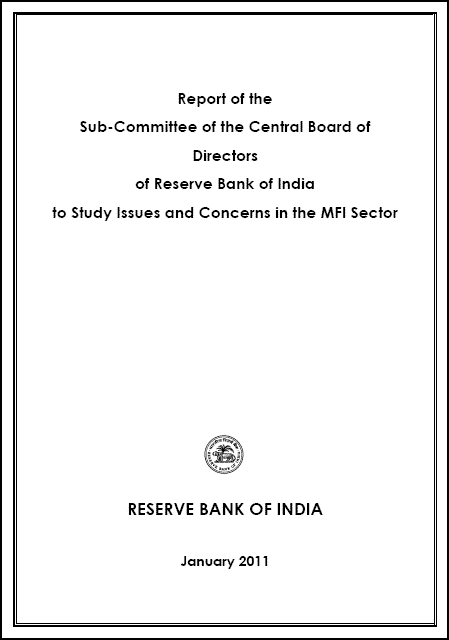We have all been waiting for this report[i] and here is the summary of recommendations…taken from the report…I will start providing an analysis of the same, bit by bit, hereafter. “The Board of Directors of the Reserve Bank of India, at its meeting held on October 15, 2010, formed a Sub-Committee of the Board to study issues and concerns in the microfinance sector in so far as they related to the entities regulated by the Bank.
THE COMPOSITION OF THE SUB-COMMITTEE WAS AS UNDER:-
- Shri Y.H. Malegam – Chairman 2. Shri Kumar Mangalam Birla 3. Dr. K. C. Chakrabarty 4. Smt. Shashi Rajagopalan 5. Prof. U.R. Rao 6. Shri V. K. Sharma (Executive Director) – Member Secretary 1.3 The terms of reference of the Sub-Committee were as under:
- To review the definition of ‘microfinance’ and ‘Micro Finance Institutions (MFIs)’ for the purpose of regulation of non-banking finance companies (NBFCs) undertaking microfinance by the Reserve Bank of India and make appropriate recommendations.
- To examine the prevalent practices of MFIs in regard to interest rates, lending, and recovery practices to identify trends that impinge on borrowers’ interests.
- To delineate the objectives and scope of regulation of NBFCs undertaking microfinance by the Reserve Bank and the regulatory framework needed to achieve those objectives.
- To examine and make appropriate recommendations in regard to the applicability of money lending legislation of the States and other relevant laws to NBFCs/MFIs.
- To examine the role that associations and bodies of MFIs could play in enhancing transparency disclosure and best practices
- To recommend a grievance redressal machinery that could be put in place for ensuring adherence to the regulations recommended at 3 above.
- To examine the conditions under which loans to MFIs can be classified as priority sector lending and make appropriate recommendations.
- To consider any other item that is relevant to the terms of reference.
RECOMMENDATION # 1: NEW CATEGORY OF NBFCS CALLED NBFC MFIS
We would, therefore, recommend that a separate category be created for NBFCs operating in the Microfinance sector, such NBFCs being designated as NBFC-MFI. The Sub-Committee recommends that an NBFC-MFI may be defined as “A company (other than a company licensed under Section 25 of the Companies Act, 1956) which provides financial services pre-dominantly to low-income borrowers with loans of small amounts, for short-terms, on an unsecured basis, mainly for income-generating activities, with repayment schedules which are more frequent than those normally stipulated by commercial banks and which further conforms to the regulations specified in that behalf”.
RECOMMENDATION # 2: NBFC TO SATISFY CERTAIN CONDITIONS (NON-NEGOTIABLES) TO BE CLASSIFIED AS NBFC MFI
We would, therefore, recommend that an NBFC classified as an NBFC-MFI should satisfy the following conditions: a) Not less than 90% of its total assets (other than cash and bank balances and money market instruments) are in the nature of “qualifying assets.” b) For the purpose of (a) above, a “qualifying asset” shall mean a loan which satisfies the following criteria:
the loan is given to a borrower who is a member of a household whose annual income does not exceed Rs. 50,000; the amount of the loan does not exceed Rs. 25,000 and the total outstanding indebtedness of the borrower including this loan also do not exceed Rs. 25,000; the tenure of the loan is not less than 12 months where the loan amount does not exceed Rs. 15,000 and 24 months in other cases with a right to the borrower of prepayment without penalty in all cases; the loan is without collateral; the aggregate amount of loans given for income generation purposes is not less than 75% of the total loans given by the MFIs; the loan is repayable by weekly, fortnightly, or monthly installments at the choice of the borrower.
c) The income derives from other services is in accordance with the regulation specified in that behalf. We would also recommend that an NBFC which does not qualify as a NBFC-MFI should not be permitted to give loans to the microfinance sector, which in the aggregate exceed 10% of its total assets.
Areas of Concern
In particular, in the Indian context, specific areas of concern have been identified: These are: a) unjustified high rates of interest b) lack of transparency in interest rates and other charges. c) multiple lending d) upfront collection of security deposits e) over-borrowing f) ghost borrowers g) coercive methods of recovery The following recommendations are made with regard to these areas of concern. Read the rest on the Microfinance in India Blog

